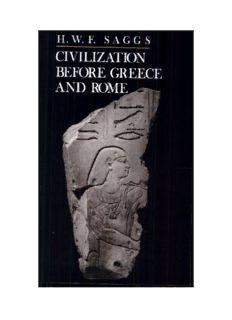
Civilization before Greece and Rome PDF
Preview Civilization before Greece and Rome
T I HE LLUSTRATIONS Plates Between pages 116 and 117 1 Prehistoric fertility figurine (Ronald Sheridan and The Ancient Art & Architecture Collection) 2 Mosque inside ruined church inside ruined Egyptian temple at Luxor (H. W. F. Saggs) 3 Step Pyramid at Saqqara (H. W. F. Saggs) 4 Transplanting a myrrh tree from Punt to Egypt (Detail from E. Naville, The Temple of Deir el Bahari, part III (898), plate LXXIV; courtesy of the Egypt Exploration Society) 5 Houses on stilts in Punt (As fig.4, plate LXIX) 6 The Queen of Punt (As fig.4, plate LXIX) 7 The Phaistos Disc (Courtesy of Peter A Clayton, F. . ., F. . ., F.R.N.S.) L A S A 8 Delivery of tribute from Nubia (N. M. Davies, The Tomb of Huy, viceroy of Nubia in the reign of Tut'ankhamun (1926), plate XXIII; courtesy of the Egypt Exploration Society) 9 From the tomb of Kemsit: delivery of products from the owner's estate (E. Naville, The XI Dynasty Temple at Deir el Bahari, part 3 (1913), plate 2; courtesy of the Egypt Exploration Society) 10 Tablet inscribed in Minoan Linear B (Courtesy of Peter A Clayton, F.L.A., F.S.A., F.R.N.S.) 11 Part of a Predynastic slate palette, showing symbols of captured Egyptian towns (Courtesy of the Egyptian Museum, Cairo) 12 Egyptian slate palette, C.3000 BC; King Na'rmer conquers his enemies (Courtesy of the Egyptian Museum, Cairo) 13 Excavated site of Indus Valley city Lothal, showing evidence of town planning (Courtesy of Professor D. P. Agrawal, India) 14 Showing accuracy of masonry in blocks of the Great Pyramid (H. W. F. Saggs) 15 The art of the goldsmith: gold pendant from Mallia in Crete (c.1650 BC) (British Museum) 16 The stele bearing Hammurabi's law code (Musees Nationaux, Paris) 17 Palm trees in natural habitat (H. W. F. Saggs) 18 Palm trees under cultivation (H. W. F. Saggs) 19 The Great Sphinx of Giza (H. W. F. Saggs) 20 Remains of the ziggurat of Borsippa, possibly the original Tower of Babel (H. W. F. Saggs) 21 Colossi near Luxor (H. W. F. Saggs) 22 The enclosure of Etemenanki and Esagila in Babylon (Reconstruction by E. Unger) 23 Snake symbol on the temple of the Yezidis (miscalled 'Devil Worshippers') in north Iraq (H. W. F. Saggs) 24 Letter to the king in Assyrian cuneiform, eighth century BC (H. W. F. Saggs) 25 Funerary furniture: the chair of Tutankhamun, showing the pharaoh and his queen (Griffith Institute, Ashmolean Museum, Oxford) Authors' Note Square brackets in the text indicate either restorations in broken texts or explanatory comment. Round brackets indicate words necessary for English idiom or clarity but not present verbatim in the original.
Description: